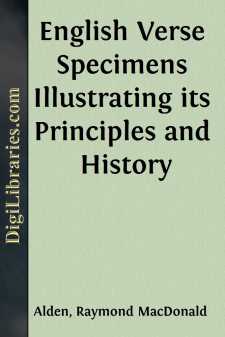Categories
- Antiques & Collectibles 13
- Architecture 36
- Art 48
- Bibles 22
- Biography & Autobiography 813
- Body, Mind & Spirit 142
- Business & Economics 28
- Children's Books 17
- Children's Fiction 14
- Computers 4
- Cooking 94
- Crafts & Hobbies 4
- Drama 346
- Education 46
- Family & Relationships 57
- Fiction 11829
- Games 19
- Gardening 17
- Health & Fitness 34
- History 1377
- House & Home 1
- Humor 147
- Juvenile Fiction 1873
- Juvenile Nonfiction 202
- Language Arts & Disciplines 88
- Law 16
- Literary Collections 686
- Literary Criticism 179
- Mathematics 13
- Medical 41
- Music 40
- Nature 179
- Non-Classifiable 1768
- Performing Arts 7
- Periodicals 1453
- Philosophy 64
- Photography 2
- Poetry 896
- Political Science 203
- Psychology 42
- Reference 154
- Religion 513
- Science 126
- Self-Help 84
- Social Science 81
- Sports & Recreation 34
- Study Aids 3
- Technology & Engineering 59
- Transportation 23
- Travel 463
- True Crime 29
English Verse Specimens Illustrating its Principles and History
Description:
Excerpt
PREFACE
The aim of this book is to give the materials for the inductive study of English verse. Its origin was in certain university courses, for which it proved to be necessary—often for use in a single hour's work—to gather almost numberless books, some of which must ordinarily be inaccessible except in the vicinity of large libraries. I have tried to extract from these books the materials necessary for the study of English verse-forms, adding notes designed to make the specimens intelligible and useful.
Dealing with a subject where theories are almost as numerous as those who have written on it, it has been my purpose to avoid the setting forth of my own opinions, and to present the subject-matter in a way suited, so far as possible, to the use of those holding widely divergent views. In the arrangement and naming of the earlier sections of the book, some systematic theory of the subject—accepted at least tentatively—was indeed indispensable; but I trust that even here those who would apply to English verse a different classification or terminology may be able to discard what they cannot approve and to make use of the specimens from their own standpoint. Even where (as in these introductory sections) the notes seem to overtop the text somewhat threateningly, they are invariably intended—as the type indicates—to be subordinate. Where it has been possible to do so, I have preferred to present comments on the specimens in the words of other writers, and have not confined these notes to opinions with which I wholly agree, but only to those which seem worthy of attention. My own views on the more disputed elements of the subject (such as the relations of time and accent in our verse, the presence of "quantity" in English, and the terminology of the subject) I have reserved for Part Three, where I trust they will be found helpful by some readers, but where they may easily be passed over.
To classify the materials of this subject is peculiarly difficult, and one who tries to solve the problem will early abandon the hope of being able to follow any system with consistency. Main divisions and subdivisions will inevitably conflict and overlap. For practical purposes, basing my arrangement in part on that found convenient in university lectures (which it will be seen is not altogether unlike that followed by Schipper in his Englische Metrik), I have divided the specimens of verse into two main divisions, each of which is suggested by a word in the sub-title of the book. Part One contains specimens designed to illustrate the principles of English verse, arranged in topical order. Part Two contains specimens designed to illustrate the history of the more important forms of English verse, arranged—in the several divisions—in chronological order. Part Three has already been spoken of. Part Four contains extracts from important critical writers on the place and function of the verse-element in poetry,—matters which give us the raison d'être for the whole study of versification....


